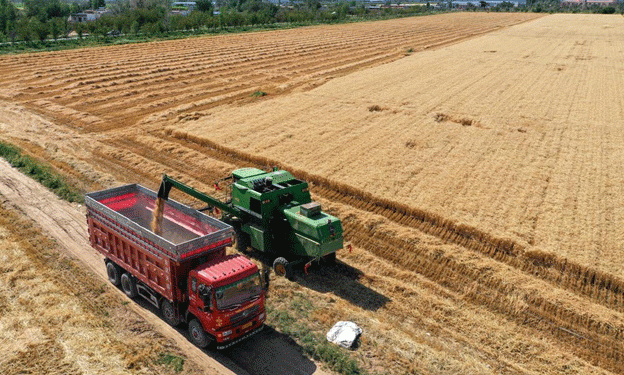Xinjiang is pivotal in China’s agricultural landscape, particularly for wheat production. The autonomous region’s vast, fertile plains and favorable climatic conditions make it an ideal location for growing high-yield wheat varieties. Qitai County, situated on the northern foothills of the Tianshan Mountains, is at the heart of this agricultural hub.
In 2023, China produced approximately 134 million metric tons of wheat, positioning it as the world’s largest wheat producer. Xinjiang contributes significantly to this total, with the region’s output playing a crucial role in ensuring China’s food security. The wheat from Xinjiang is not only vital for domestic consumption but also for maintaining the country’s strategic grain reserves.
Technological Advancements in Harvesting
The use of modern agricultural technology is evident in Qitai County. Farmers are employing advanced machinery for harvesting, which enhances efficiency and reduces labor costs. The use of drones for monitoring and managing the fields ensures optimal crop health and maximizes yield. This technological integration is part of a broader trend in Chinese agriculture, aimed at modernizing farming practices and improving productivity.
Challenges and Solutions
Despite the region’s agricultural potential, farmers in Xinjiang face several challenges. Climate change poses a significant threat, with shifting weather patterns affecting crop yields. Additionally, water scarcity is a persistent issue in this arid region, necessitating efficient irrigation practices.
To address these challenges, the Chinese government has implemented various support measures. These include investing in advanced irrigation systems, providing subsidies for modern farming equipment, and promoting research into drought-resistant crop varieties. Such initiatives are crucial for sustaining and enhancing Xinjiang’s agricultural productivity.
The Economic Impact
The wheat harvest season is a critical period for the local economy in Qitai County. The successful harvesting of wheat not only ensures food supply but also boosts the livelihoods of local farmers. The sale of wheat contributes to the regional economy, supporting various sectors including transportation, storage, and processing industries.
As Qitai County in Xinjiang enters its wheat harvest season, the region’s significance as a major grain producer comes to the forefront. The combination of fertile land, favorable climate, and modern agricultural practices enables Xinjiang to play a vital role in China’s wheat production. However, ongoing challenges such as climate change and water scarcity require continuous innovation and support to ensure sustainable agricultural growth. The bustling activity captured by drones on July 9 is a testament to the hard work and resilience of Xinjiang’s farmers, who remain at the heart of China’s efforts to secure its food future.
Error




